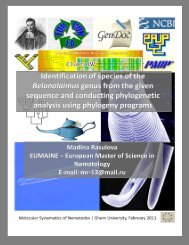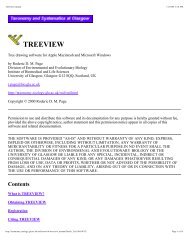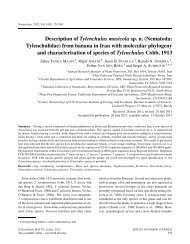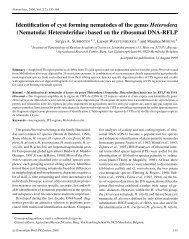Variations in ribosomal DNA sequences and phylogeny of - Russian ...
Variations in ribosomal DNA sequences and phylogeny of - Russian ...
Variations in ribosomal DNA sequences and phylogeny of - Russian ...
Create successful ePaper yourself
Turn your PDF publications into a flip-book with our unique Google optimized e-Paper software.
(Thompson et al., 1997) <strong>and</strong> edited us<strong>in</strong>g GeneDOC (version<br />
2.5.0, Nicholas & Nicholas, 1997). The boundaries<strong>of</strong><br />
ITS1 <strong>and</strong> ITS2 were determ<strong>in</strong>ed by compar<strong>in</strong>g the aligned<br />
<strong>sequences</strong>with previouslypublished<strong>sequences</strong> <strong>of</strong> G. pallida<br />
<strong>and</strong> G. rostochiensis(Bulman & Marshall, 1997; Blok<br />
et al., 1998).<br />
The follow<strong>in</strong>g alignments were created: the D3 regions<br />
<strong>of</strong> the 28S genes <strong>of</strong> orig<strong>in</strong>al <strong>sequences</strong> <strong>of</strong> Globodera; the<br />
ITS regions, <strong>in</strong>clud<strong>in</strong>g the 5.8S r<strong>DNA</strong> genes plus � ank<strong>in</strong>g<br />
areas <strong>of</strong> the 18S <strong>and</strong> 28S genes <strong>of</strong> orig<strong>in</strong>al <strong>sequences</strong> for<br />
comparison <strong>of</strong> sequence <strong>and</strong> RFLP data (Fig. 1); the entire<br />
ITS regions <strong>and</strong> the ITS1 region <strong>of</strong> orig<strong>in</strong>al <strong>and</strong> published<br />
<strong>sequences</strong> for sequence <strong>and</strong> phylogenetic analyses;<br />
two separated alignments conta<strong>in</strong><strong>in</strong>g the ITS2 region<br />
or 5.8S gene <strong>sequences</strong> for sequence analyses. Multiple<br />
alignments have not been <strong>in</strong>cluded <strong>in</strong> this paper but are<br />
available on request from the senior author. Orig<strong>in</strong>al <strong>sequences</strong><br />
<strong>of</strong> the D3 expansion region <strong>of</strong> 28S genes are submitted<br />
at the GenBank.<br />
SEQUENCE AND PHYLOGENETIC ANALYSIS<br />
Unweighted maximum parsimony analysis was performed<br />
us<strong>in</strong>g PAUP (4.0 beta version) (Sw<strong>of</strong>ford, 1998)<br />
us<strong>in</strong>g heuristic search (TBR branch swapp<strong>in</strong>g, collapse<br />
yes, multrees yes, steepest descent no, gaps were treated<br />
as miss<strong>in</strong>g data). Bootstrap (Felsenste<strong>in</strong>, 1985) analysis<br />
with 100 replicates was conducted to assess the degree <strong>of</strong><br />
support for each branch on the tree. Different measures <strong>of</strong><br />
homoplasy, such as consistency <strong>in</strong>dex (CI) (Kluge & Farris,<br />
1969), retention <strong>in</strong>dex (RI) <strong>and</strong> rescaled consistency<br />
<strong>in</strong>dex (RC) (Farris, 1989) <strong>and</strong> also g1 statistic, a measure<br />
<strong>of</strong> skewness <strong>of</strong> tree-length distribution(Hillis & Huelsenbeck,<br />
1992), were computed to estimate the amount <strong>of</strong><br />
phylogenetic <strong>in</strong>formation <strong>in</strong> the parsimony analysis. The<br />
g1 statistic was computed by generat<strong>in</strong>g 10 000 r<strong>and</strong>om<br />
parsimonioustrees us<strong>in</strong>g the R<strong>and</strong>omtree option <strong>in</strong> PAUP.<br />
Pairwise divergence between taxa as the absolute distance<br />
values <strong>and</strong> the percent mean distance values based on the<br />
ITS1, ITS2, 5.8S <strong>and</strong> the entire ITS alignment <strong>and</strong> adjusted<br />
for miss<strong>in</strong>g data were computed.<br />
Distance analyses were performed us<strong>in</strong>g PAUP (4.0<br />
beta version)with LogDet method(Lockhart et al., 1994),<br />
the distance trees were constructed by the neighbourjo<strong>in</strong><strong>in</strong>g<br />
method (Saitou & Nei, 1987). Bootstrap values<br />
based on 1000 resampl<strong>in</strong>g were estimated. Trees were<br />
exam<strong>in</strong>ed with TREEVIEW program (Page, 1996).<br />
Results<br />
SEQUENCE ANALYSIS<br />
Ribosomal <strong>DNA</strong> <strong>and</strong> <strong>phylogeny</strong> <strong>of</strong> Globodera<br />
The ampli� cation by PCR <strong>of</strong> the D3 expansion region<br />
<strong>of</strong> the large subunit 28S r<strong>DNA</strong> gene for each population<strong>of</strong><br />
Globodera yielded a s<strong>in</strong>gle PCR product with a length <strong>of</strong><br />
approximately 340 bp. Identical <strong>sequences</strong> were obta<strong>in</strong>ed<br />
from populations<strong>of</strong> G. rostochiensis<strong>and</strong> G. pallida. There<br />
was no variation between the eight populations (Gr-Ga,<br />
Gr-Kh, Gr-Ja, Gr-Tu, Gr-Vl, Gr-Sm, Gr-Ps <strong>and</strong> Gr-Ro)<br />
<strong>of</strong> G. rostochiensis that were analysed. There were also<br />
no sequence variations <strong>in</strong> this region between G. tabacum<br />
tabacum, G. tabacum solanacearum <strong>and</strong> G. tabacum virg<strong>in</strong>iae,<br />
<strong>and</strong> the difference between <strong>sequences</strong> <strong>of</strong> the PCN<br />
populations <strong>and</strong> species <strong>of</strong> the G. tabacum complex was<br />
<strong>in</strong> only one nucleotide replacement.<br />
The r<strong>DNA</strong>1 <strong>and</strong> r<strong>DNA</strong>2 primers gave ITS-PCR products<br />
<strong>of</strong> ca 1190 bp from all species <strong>and</strong> populations.<br />
Other weak b<strong>and</strong>s, probably from non-speci� c ampli� cation,<br />
were excluded from the further analysis. Three ITS<br />
clones from the Gr-Ga <strong>and</strong> Gr-Ro populations,two clones<br />
from the Gr-Kh, Gr-Ja <strong>and</strong> Gr-Tu populations,� ve clones<br />
from G. pallida <strong>and</strong> two clones from each <strong>of</strong> G. tabacum<br />
tabacum, G. tabacum virg<strong>in</strong>iae <strong>and</strong> G. tabacum solanacearum<br />
were sequenced. The PCR product from the Gr-<br />
Tu population <strong>of</strong> G. rostochiensis was also directly sequenced.<br />
The aligned orig<strong>in</strong>al <strong>sequences</strong> from clones <strong>of</strong> G. rostochiensis<br />
(Gr-Ja1), G. pallida (Gp-Pa1), G. tabacum<br />
tabacum (Gt-Tab1), G. tabacum virg<strong>in</strong>iae (Gt-Vir1) <strong>and</strong><br />
G. tabacum solanacearum(Gt-Sol1) are shown <strong>in</strong> Fig. 1.<br />
Sequence analysis showed that 11 G. rostochiensis clones<br />
had sequence lengths <strong>of</strong> 1191 bp <strong>in</strong>clud<strong>in</strong>g primers, <strong>and</strong><br />
one clone (Gr-Ro2) had a sequence length <strong>of</strong> 1190 bp.<br />
Twelve po<strong>in</strong>t mutations <strong>in</strong> the ampli� ed region were observed<br />
between 12 clones. Five <strong>of</strong> the po<strong>in</strong>t mutations<br />
were situated <strong>in</strong> the ITS1 region, one <strong>in</strong> the 5.8S gene <strong>and</strong><br />
six <strong>in</strong> the ITS2 region. These nucleotide differences corresponded<br />
to three types <strong>of</strong> ITS1 (A, B <strong>and</strong> C) <strong>and</strong> three<br />
types <strong>of</strong> ITS2 regions (a, b <strong>and</strong> c) (Table 3). Types Aa<br />
<strong>and</strong> Cc were found three times, Bb � ve times <strong>and</strong> Cb only<br />
once among the clones studied; the last type conta<strong>in</strong>edtwo<br />
base pair deletions. Population Gr-Ga conta<strong>in</strong>ed clones<br />
with Aa, Bb <strong>and</strong> Cc, Gr-Kh conta<strong>in</strong>ed Bb <strong>and</strong> Cc, Gr-<br />
Ja conta<strong>in</strong>ed Bb, Gr-Tu conta<strong>in</strong>ed Aa <strong>and</strong> Cc <strong>and</strong> Gr-Ro<br />
conta<strong>in</strong>ed Aa, Bb <strong>and</strong> Cb types <strong>of</strong> ITS regions (Table 3).<br />
Direct sequenc<strong>in</strong>g <strong>of</strong> the Gr-Tu ITS regions revealed the<br />
same ambiguous or heterogeneous nucleotide positions at<br />
vary<strong>in</strong>g <strong>in</strong>tensities.<br />
Vol. 2(6), 2000 595
















